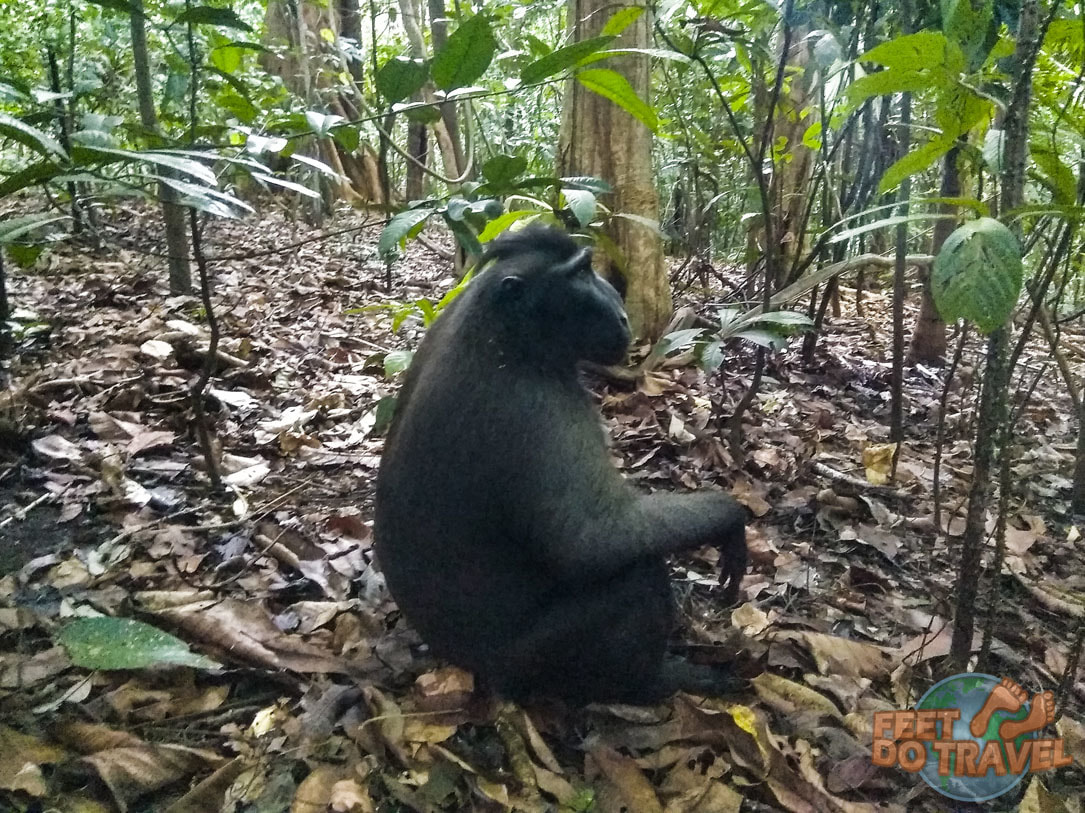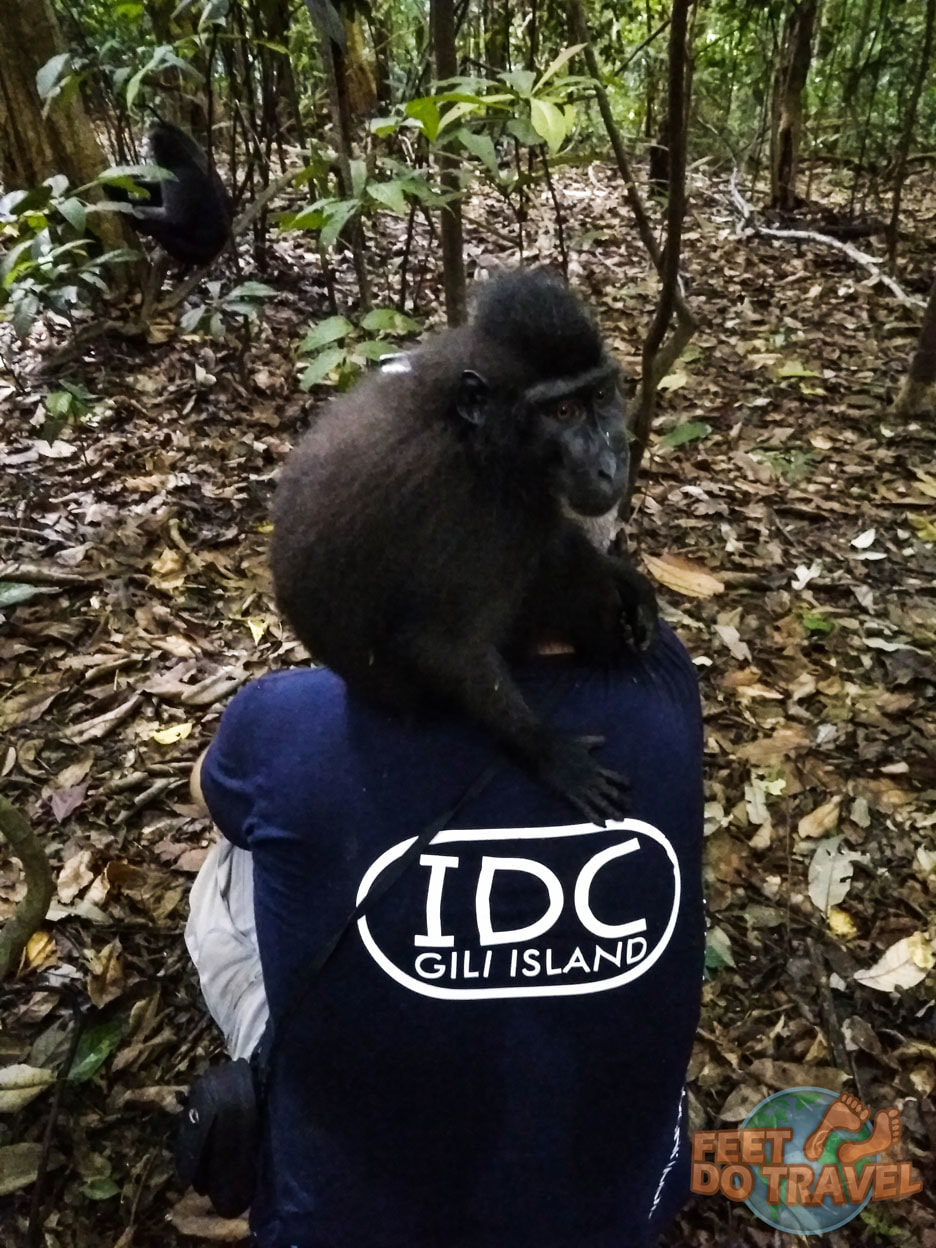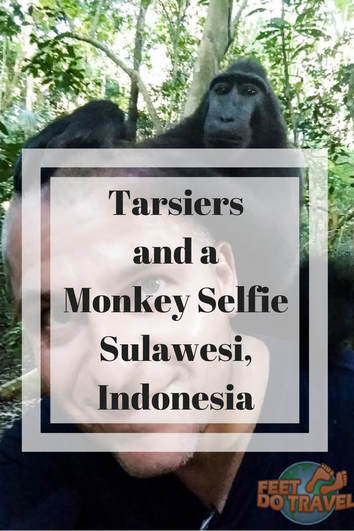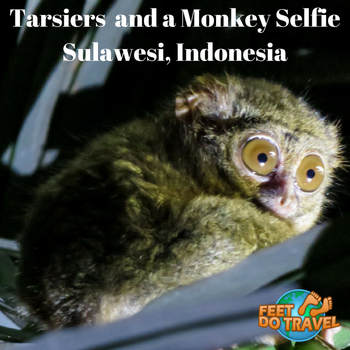
Unique and rare, Tarsiers are found in Tangkoko Nature Reserve, North Sulawesi in Indonesia. When we were scuba diving in Lembeh, we were only an hour away from the Park, so couldn’t pass up the chance to view these weird and wonderful, googly eyed creatures.
However it wasn’t just the Tarsiers who left a lasting impression. Tangkoko Nature Reserve is the setting for the infamous monkey selfie lawsuit, and home to Black Crested Macaque, Kuskus, Hornbills, Kingfishers and a plethora of birds only found in Sulawesi. It’s a bird watcher’s paradise, and people come from all over the world for the rare birds found here.
If it wasn’t the Tarsiers who were the star of the show … what was?
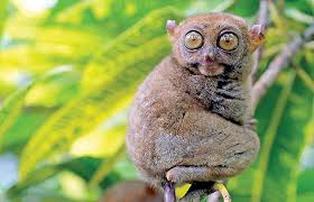
Tarsiers get their name from the elongated tarsus bones in their feet, which enables them to jump as far as 3 metres from one tree to another, which we saw for ourselves.
But that’s not all which is strange about this petite primate …
- Their exceptionally long fingers look like human skeleton hands covered with fur.
- Their eyes are the size of saucers .. not really, but they are as big and as heavy as their brain.
- Just like an owl, their eyes cannot be rotated in their socket, instead, their head rotates 180 degrees.
- They are nocturnal, so have excellent night vision, but despite their large eyes, during the daytime they can hardly see.
- Dating back 45 million years, Tarsiers are one of the oldest primates in the world.
- They have soft, velvety fur, a body length of 10-15 cm, and weigh around 80 grams.
- Don’t be fooled by their cute and fluffy appearance. Tarsiers are strictly carnivorous feeding mainly on insects, and are excellent ambush predators able to grab a bat or bird out of the air.
- Tarsiers are only found in a few places within South East Asia, and it's one of the wildlife you can see in the Philippines. All are vulnerable to extinction due to loss of habitat.
Viewing the Tarsiers

At dusk, our park guide took us to hang out by a tree where a family of six were living. They were curled up in tight little balls, not too dissimilar to Gizmo from the Hollywood movie Gremlins.
The Black Crested Macaque,also known as the black monkey, are indigenous to North Sulawesi, living freely in Tangkoko Nature Reserve. The entirely jet black monkey has unusually striking red/brown eyes, but are fearless of man in Tangkoko because here, they aren’t hunted.
Despite being critically endangered, Black Crested Macaques are hunted and slaughtered for their meat. In Sulawesi they have been eaten for centuries, and are considered a delicacy by locals. Their meat can be found in Bitung town’s open market.
In Sulawesi they devastate crops and fields, are considered a pest and also caught to keep as pets. Even though there is an Indonesian law protecting them, the law means nothing if it isn’t enforced. If the police do catch an illegal hunter, jail time is rare, and hunters may only be given a fine. This means there is little incentive to stop what they’re doing. Rain forest clearing also threatens their survival.
Have you heard of the monkey selfie story? Back in 2011, Naruto, a black crested macaque living in Tangkoko Nature Reserve, picked up photographer David Slater’s unattended camera from the ground, and snapped a selfie.
PETA tried to sue David Slater for publishing the monkey selfie, stating that it was a violation of the monkey’s copyright, and the monkey owned the right to the image. An Appeals Court determined that a monkey cannot own copyright. PETA lost the case and had to pay all of Mr Slater’s costs.
Mr Slater agreed to donate 25% of any future revenue from the now famous image to charities dedicated to protecting crested macaques in Indonesia.
We followed the Indonesia Tourism guideline (and I quote) “When viewing monkeys, let them approach you on their own terms. If you stoop down and avoid looking directly in their eyes they will be less inhibited. Do not chase or pursue monkeys and never feed them. No matter how innocent they may look, wild monkeys bite and carry dangerous diseases.”
Our guide informed us that there was a family of around 90 black macaques nearby, so walked to find them. We snapped a few photos from a distance as they swung from tree to tree, and rolled down the leafy embankments acting as monkeys do.
After around 30 minutes, we decided to make our way to the tarsiers, but along the way we past the chief being groomed.
Despite feeling nervous, Sy remained calm as he didn’t want to startle the macaque who, after all, was just being a curious monkey.
Curiosity satisfied, he jumped off and ran into the forest. (the macaque, not Sy)
Where is Tangkoko Nature Reserve?
Tangkoko is a 8,700 hectare Nature Reserve located in the district of Bitung, on the north of Sulawesi island, Indonesia.
From Manado airport: Two hour’s drive
From Lembeh island: One and a half hours.
There is a car park at the entrance along with toilets. After a few minutes of walking on a concrete path (being constructed for the impending Indonesian President’s visit), you are in a natural park, with the usual forest like growth underfoot.
When is the best time to visit?
The best time to visit are the months of June and September, when there are less crowds and rain. It’s best to visit early morning when there is more bird and wildlife activity, or late in the afternoon.
Indonesia is a tropical year round destination with two seasons. Wet season is October to April/May, dry season is June to September, although high seasons is July and August.
What should I wear and do I need to take anything?
Long trousers
Comfortable walking shoes/sandals
Mosquito repellent
Binoculars
Camera with long lens
Torch
Tissues/antibacterial handwash
How much does it cost to enter the Nature Reserve?
Entrance fee: 100,000 IDR per person
Guide (evening): 100,000 IDR per person
Guide (morning): 200,000 IDR per person
Note: Guides speak excellent English, are extremely knowledgeable and passionate about the park’s birds and wildlife.
Lembeh, Indonesia Travel Facts
• A 30 day visa is given at the time of arrival in Indonesia (not for all countries, check with your embassy).
• The local currency is Indonesian Rupiah £1 GBP = 18,000 IDR
• Their official language is Bahasa Indonesia which is similar to Malaysian and throughout Indonesia in general
• If you can use just a couple of Indonesian words, this will give you big smile in return, even if you simply use “Pagi” (morning) and “Terima Kasih” (thank you), it will be hugely appreciated.
• The religion is mainly Christian.
Have you ever seen a Tarsier or had a wild monkey encounter? Tell us in the comment section below, we want to know!

Book your Sulawesi, Indonesia, holiday, or weekend break hotel through our Hotel Booking Page. We always use Booking.com, and are proud to have a partnership with them.
Pin this post for future reference!
Lembeh - A Magical Muck Diving Experience
Raja Ampat on a Budget
Diving Raja Ampat
Komodo Dragon Hike in Rinca
Komodo, Flores, More Than Just Dragons
Scuba Diving the Gili Islands
Best Sunset Spots on Gili Air
10 Must Try Indonesian Dishes
Manta Madness
USS Liberty in Bali - Highly Wreck-Ommended
Gili Asahan - The Secret Gili Islands
Gili Gede - The Secret Gili Islands
Gili Sudak and Gili Kedis - The Secret Gili Islands
Indonesian Orangutan Adventure
Derawan & Sangalaki - Borneo's Hidden Gem?












